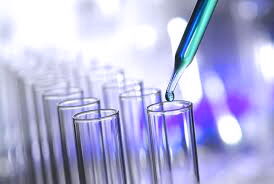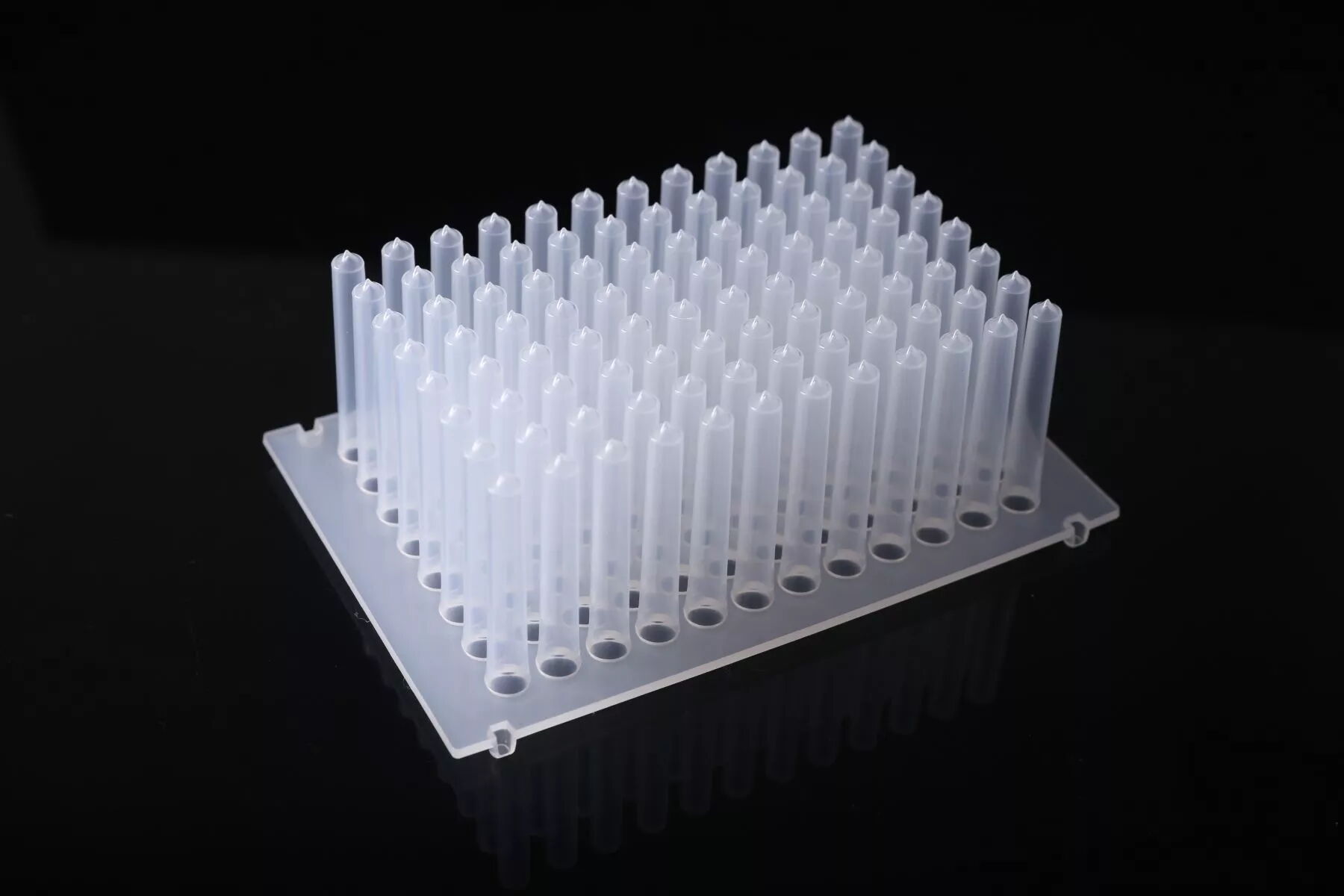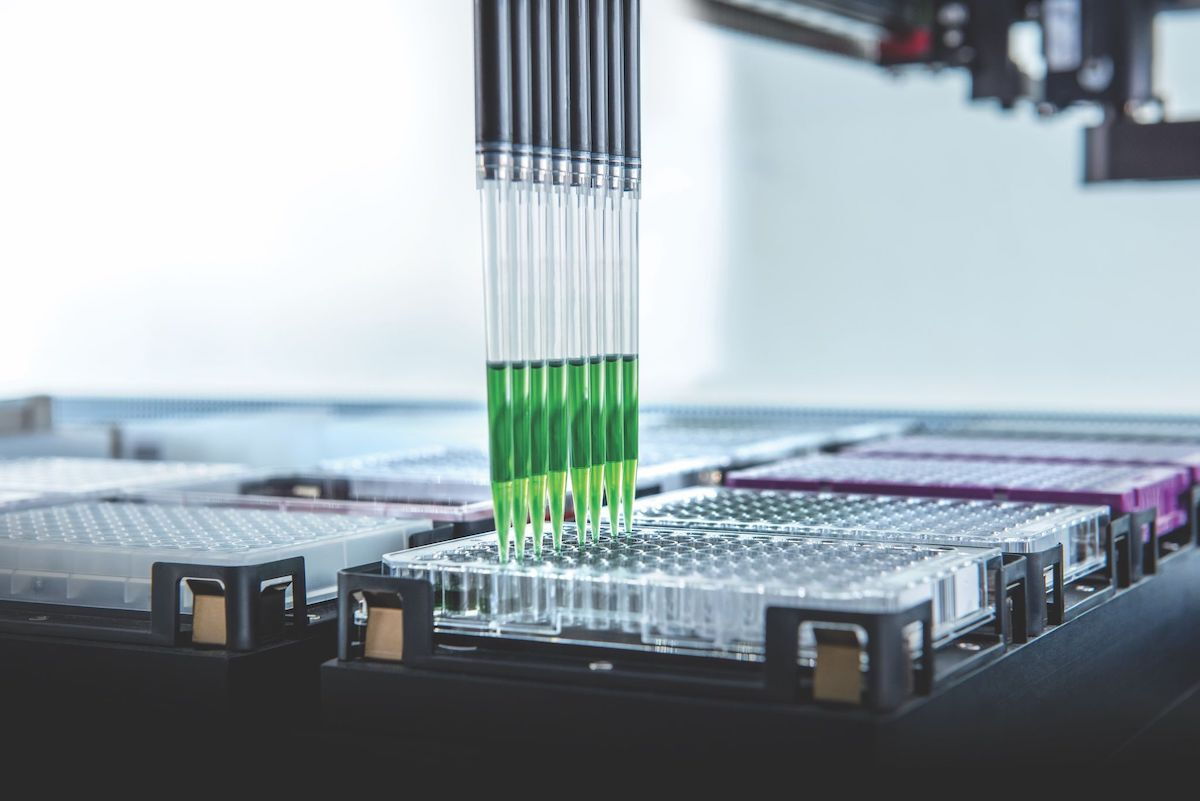Features and Selection of PCR Consumables
Nov 28, 2023
PCR consumables, including PCR tubes (EP tubes), 8-tube strips, 96-well PCR plates, and deep well plates, are commonly made from polypropylene (PP) material. They boast high quality, purity, and transparency and are typically manufactured in cleanroom environments.
Why is PCR consumable material generally PP, and why is a clean environment necessary?
PCR/qPCR consumables often come into direct contact with reagents or samples, and polypropylene (PP) is chosen for its biological inertness. The material's surface resists the adhesion of biomolecules, and it exhibits excellent chemical resistance and temperature tolerance (capable of withstanding high-pressure autoclaving at 121°C and temperature variations during thermal cycling).
Emphasizing the importance of consumable quality (cleanliness), PCR consumables must be free from contaminants and inhibitors. While high pressure and radiation can eliminate bacteria and DNA enzymes, they cannot remove dust and residual DNA, which may inhibit PCR reactions or lead to nonspecific amplification. Even small contaminants with absorbance properties can affect fluorescence signal collection. Therefore, the entire production process, from mold fabrication to final packaging of these plastic consumables, must be conducted in facilities with restricted particle counts.
High Thermal Conductivity
Extremely thin wall thickness optimizes heat transfer, reducing cycling time.
Does thicker material provide better stability for PCR plates/tubes?
No, the wall thickness of the tube directly affects thermal conductivity, and an extremely thin wall optimizes heat transfer, reducing cycling time. To enhance PCR reaction efficiency, ensure stable and efficient reactions, uniform, ultra-thin-walled PCR consumables are the preferred choice.
High Reflectance of Fluorescent Signals
qPCR recommends the use of high-quality white PCR consumables.
Tube caps: High light transmittance; the cap's light transmission directly affects signal acquisition, making it crucial for accurate fluorescence quantitative detection.
How to choose different-colored PCR tubes/plates?
For regular PCR reactions, transparent or colored PCR tubes are suitable, with colored transparent tubes aiding in sample classification management. However, qPCR recommends the use of high-quality white PCR consumables. Since qPCR requires real-time quantitative detection of fluorescence signal intensity, it demands sensitive and accurate fluorescence signal transmission. Studies have shown that compared to traditional transparent PCR products, white PCR products maximize fluorescence signal reflection, reducing inter-well signal cross-contamination and optimizing real-time fluorescence quantitative PCR results.
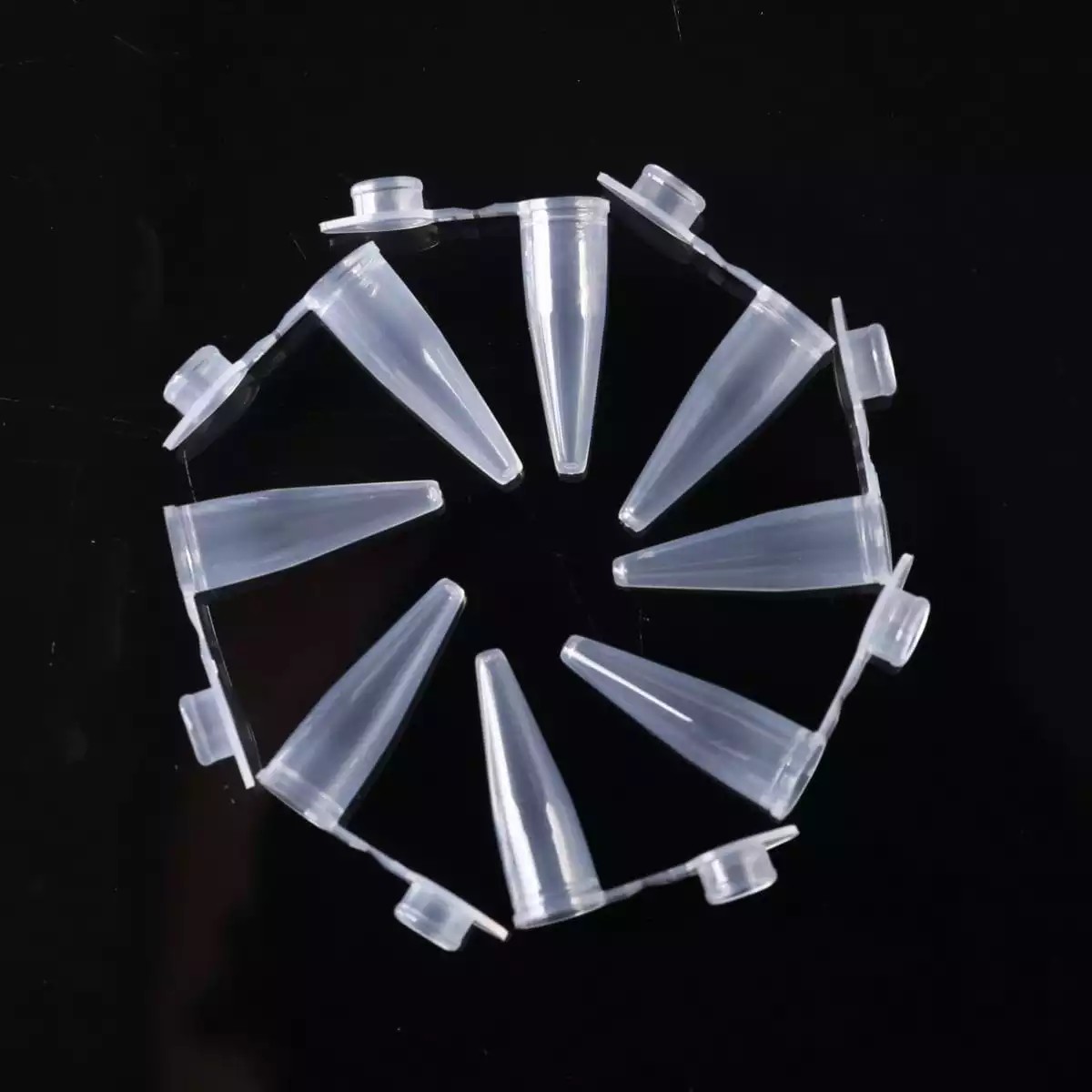
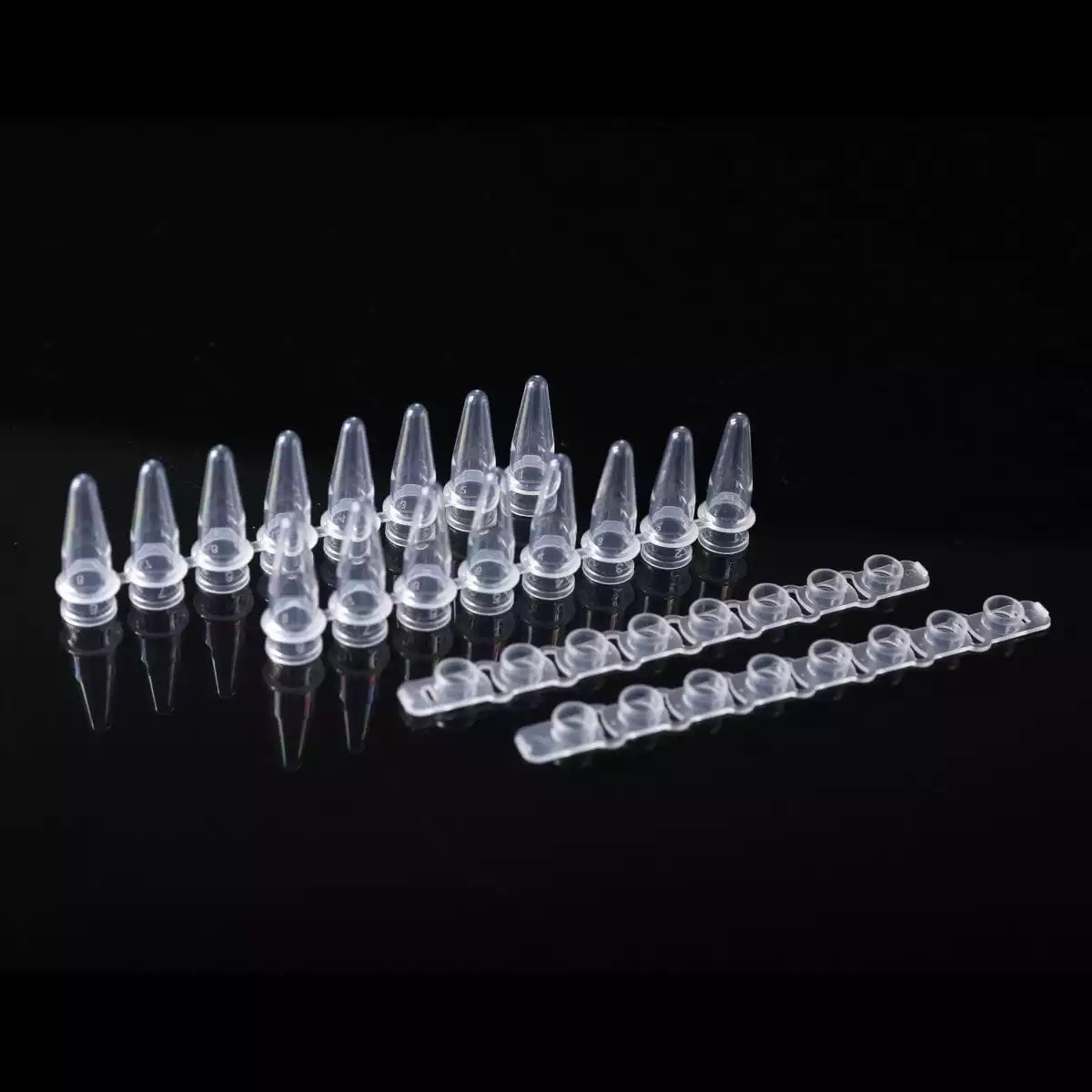
High Contamination Resistance
Tight-fitting lids with good lid-to-tube compatibility reduce cross-contamination.
PCR plates should have raised edges for effective sealing.
One end with a handle strip, and strip caps should have a prominent handle end, reducing contamination when opening.
Why do some PCR plates have raised wells, while others are flat? Which one is better?
The choice between flat and raised well edges depends on the instrument requirements for positioning. Flat-edged reaction plates are suitable for most PCR instruments. Raised well edges facilitate sealing with films, reducing the risk of cross-contamination between samples.
High Discriminability
Numerical and alphabetical markings aid in identifying individual wells and sample positions.
Cut angles assist in recognizing the orientation.
Why are the cut angles and markings different for some 96-well or 384-well plates?
The placement of cut angles and markings on PCR plates depends on their intended purpose. Cut angles in PCR plates are chosen based on instrument requirements for easy positioning. Numerical and alphabetical markings on PCR plates help identify individual wells and sample positions. Typically, there are raised color-coded numerical markings or engraved markings. For some automated applications, plates with engraved markings provide better sealing.
Accurate Volume
Sealing: Tight lids or alternative methods such as film sealing reduce evaporation.
How to choose PCR tubes/plates of different volumes?
Guiding principle: Select the appropriate product based on specific experimental requirements. Most PCR tube volumes meet the demands of PCR reactions. On this basis, it is recommended to prioritize low-volume tubes. Low-volume tubes have a smaller headspace, improving thermal conductivity and reducing evaporation. Moreover, during sample addition, it is essential to avoid overloading or underloading. Excessive volume can lead to decreased thermal conductivity, overflow, and cross-contamination, while insufficient volume may result in sample evaporation loss.
Common specifications and volumes of PCR tubes:
Single tube/8-tube strip/12-tube strip: 0.5mL, 0.2mL, 0.15mL, 0.1mL
96-well plate: 0.2mL, 0.15mL, 0.1mL
384-well plate: 0.04mL
Ease of Use
PCR consumables should be easy to handle, such as lids being easy to close without compromising seal integrity. PCR consumables must be well-matched with PCR instruments.
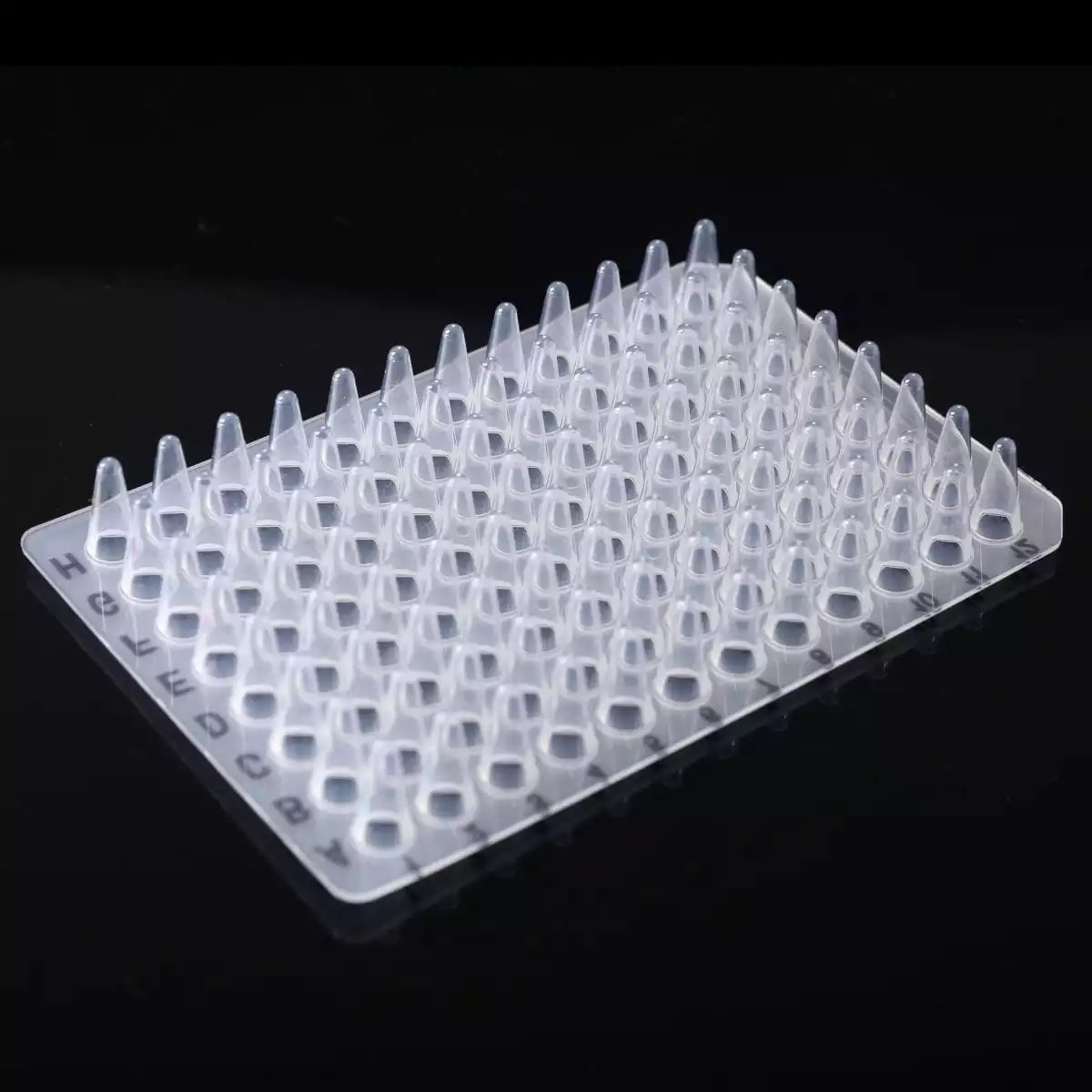
Why do some 96-well or 384-well plates have skirts, while others do not?
In fact, the skirts on PCR/qPCR plates are designed to better accommodate automated applications, providing stable support and mechanical strength for instruments. Additionally, plates with skirts offer higher stability during pipetting processes. PCR plates are generally divided into unskirted, semi-skirted, and fully skirted types.
Unskirted plates: Suitable for most PCR or qPCR instruments but not suitable for automated applications. Lower stability during pipetting, requiring the use of a plate holder.
Semi-skirted plates: Suitable for labeling or barcode applications and automation, with better stability during pipetting.
Fully skirted plates: Highly suitable for automated experiments, compatible with labels and barcodes. These plates have good mechanical strength, making them suitable for PCR instruments with raised modules, and they offer high stability during pipetting.
Choosing high-quality sealing film that suits the PCR plate is essential. It not only effectively protects samples and prevents contamination but also provides reliable experimental data.
Why is PCR consumable material generally PP, and why is a clean environment necessary?
PCR/qPCR consumables often come into direct contact with reagents or samples, and polypropylene (PP) is chosen for its biological inertness. The material's surface resists the adhesion of biomolecules, and it exhibits excellent chemical resistance and temperature tolerance (capable of withstanding high-pressure autoclaving at 121°C and temperature variations during thermal cycling).
Emphasizing the importance of consumable quality (cleanliness), PCR consumables must be free from contaminants and inhibitors. While high pressure and radiation can eliminate bacteria and DNA enzymes, they cannot remove dust and residual DNA, which may inhibit PCR reactions or lead to nonspecific amplification. Even small contaminants with absorbance properties can affect fluorescence signal collection. Therefore, the entire production process, from mold fabrication to final packaging of these plastic consumables, must be conducted in facilities with restricted particle counts.
High Thermal Conductivity
Extremely thin wall thickness optimizes heat transfer, reducing cycling time.
Does thicker material provide better stability for PCR plates/tubes?
No, the wall thickness of the tube directly affects thermal conductivity, and an extremely thin wall optimizes heat transfer, reducing cycling time. To enhance PCR reaction efficiency, ensure stable and efficient reactions, uniform, ultra-thin-walled PCR consumables are the preferred choice.
High Reflectance of Fluorescent Signals
qPCR recommends the use of high-quality white PCR consumables.
Tube caps: High light transmittance; the cap's light transmission directly affects signal acquisition, making it crucial for accurate fluorescence quantitative detection.
How to choose different-colored PCR tubes/plates?
For regular PCR reactions, transparent or colored PCR tubes are suitable, with colored transparent tubes aiding in sample classification management. However, qPCR recommends the use of high-quality white PCR consumables. Since qPCR requires real-time quantitative detection of fluorescence signal intensity, it demands sensitive and accurate fluorescence signal transmission. Studies have shown that compared to traditional transparent PCR products, white PCR products maximize fluorescence signal reflection, reducing inter-well signal cross-contamination and optimizing real-time fluorescence quantitative PCR results.


High Contamination Resistance
Tight-fitting lids with good lid-to-tube compatibility reduce cross-contamination.
PCR plates should have raised edges for effective sealing.
One end with a handle strip, and strip caps should have a prominent handle end, reducing contamination when opening.
Why do some PCR plates have raised wells, while others are flat? Which one is better?
The choice between flat and raised well edges depends on the instrument requirements for positioning. Flat-edged reaction plates are suitable for most PCR instruments. Raised well edges facilitate sealing with films, reducing the risk of cross-contamination between samples.
High Discriminability
Numerical and alphabetical markings aid in identifying individual wells and sample positions.
Cut angles assist in recognizing the orientation.
Why are the cut angles and markings different for some 96-well or 384-well plates?
The placement of cut angles and markings on PCR plates depends on their intended purpose. Cut angles in PCR plates are chosen based on instrument requirements for easy positioning. Numerical and alphabetical markings on PCR plates help identify individual wells and sample positions. Typically, there are raised color-coded numerical markings or engraved markings. For some automated applications, plates with engraved markings provide better sealing.
Accurate Volume
Sealing: Tight lids or alternative methods such as film sealing reduce evaporation.
How to choose PCR tubes/plates of different volumes?
Guiding principle: Select the appropriate product based on specific experimental requirements. Most PCR tube volumes meet the demands of PCR reactions. On this basis, it is recommended to prioritize low-volume tubes. Low-volume tubes have a smaller headspace, improving thermal conductivity and reducing evaporation. Moreover, during sample addition, it is essential to avoid overloading or underloading. Excessive volume can lead to decreased thermal conductivity, overflow, and cross-contamination, while insufficient volume may result in sample evaporation loss.
Common specifications and volumes of PCR tubes:
Single tube/8-tube strip/12-tube strip: 0.5mL, 0.2mL, 0.15mL, 0.1mL
96-well plate: 0.2mL, 0.15mL, 0.1mL
384-well plate: 0.04mL
Ease of Use
PCR consumables should be easy to handle, such as lids being easy to close without compromising seal integrity. PCR consumables must be well-matched with PCR instruments.

Why do some 96-well or 384-well plates have skirts, while others do not?
In fact, the skirts on PCR/qPCR plates are designed to better accommodate automated applications, providing stable support and mechanical strength for instruments. Additionally, plates with skirts offer higher stability during pipetting processes. PCR plates are generally divided into unskirted, semi-skirted, and fully skirted types.
Unskirted plates: Suitable for most PCR or qPCR instruments but not suitable for automated applications. Lower stability during pipetting, requiring the use of a plate holder.
Semi-skirted plates: Suitable for labeling or barcode applications and automation, with better stability during pipetting.
Fully skirted plates: Highly suitable for automated experiments, compatible with labels and barcodes. These plates have good mechanical strength, making them suitable for PCR instruments with raised modules, and they offer high stability during pipetting.
Choosing high-quality sealing film that suits the PCR plate is essential. It not only effectively protects samples and prevents contamination but also provides reliable experimental data.
Previous: The Application and Usage of Centrifuge Tubes in Biological Laboratories
Next: Key Considerations in PCR Experiments

